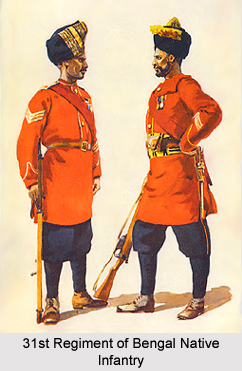 The 31st Regiment of Bengal Native Infantry, also known as 2nd Bengal Light Infantry, was an erstwhile regiment of foot-soldiers formed by the British East India Company. The infantry unit was raised in 1798 as the 2nd Battalion 15th Regiment of Bengal Native Infantry. It was a part of the Bengal Native Infantry and also functioned under the Bengal Army of Bengal Presidency. The Army of Bengal Province was one of the 3 Presidency Armies in British India.
The 31st Regiment of Bengal Native Infantry, also known as 2nd Bengal Light Infantry, was an erstwhile regiment of foot-soldiers formed by the British East India Company. The infantry unit was raised in 1798 as the 2nd Battalion 15th Regiment of Bengal Native Infantry. It was a part of the Bengal Native Infantry and also functioned under the Bengal Army of Bengal Presidency. The Army of Bengal Province was one of the 3 Presidency Armies in British India.
The 31st Regiment of Bengal Native Infantry was re-designated in 1856 as the 31st Regiment of Bengal Light Infantry. During the Sepoy Mutiny of 1857, the troops did not participate in the rebellion against the British administration against the British administration they fought in the Central India Campaign. Most of the regiments of the Bengal Army took part in the Great Revolt and were dissolved accordingly. As a result of this, the 31st Regiment of Bengal Native Infantry became the second most senior regiment. The regiment took part in a number of British battles and military conquests.
Designations of 31st Regiment of Bengal Native Infantry
The 31st Regiment of Bengal Native Infantry comprised of several titles throughout its service in the British Indian Army. These are mentioned as follows-
* 2nd Battalion 15th Regiment of Bengal Native Infantry - 1798
* 31st Regiment of Bengal Native Infantry - 1824
* 31st Regiment of Bengal Light Infantry - 1856
* 2nd Bengal Light Infantry - 1861
Battle Honours of 31st Regiment of Bengal Native Infantry
The troops of the 31st Regiment of Bengal Native Infantry were honoured with a number military awards and battle honours for their valiant services. The Battle Honours received by the regiment are mentioned below-
* Laswaree
* Delhi 1803
* Bhurtpore (Bharatpur)
* Deig
* Afghanistan
* Khelat
* Punjaub (Punjab)
* Maharajpore
* Goojerat (Gujrat)
* Chillianwallah
* Afghanistan (1879- 1880)
* Central India
* Burma 1885-87
* China 1900
* Afghanistan 1919
* First World War
This article is a stub. You may enrich it by adding more information to it. You can send your write-up at content@indianetzone.com



















